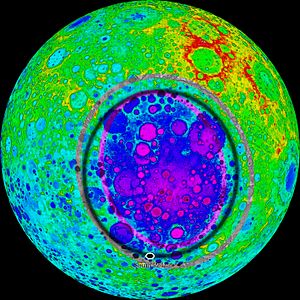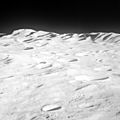South Pole–Aitken basin facts for kids
The South Pole–Aitken basin is a giant hole on the far side of the Moon. It was made by something big crashing into the Moon a very long time ago. This basin is about 2,500 kilometers (1,550 miles) wide and 13 kilometers (8 miles) deep. It is one of the biggest impact craters in our entire Solar System. It's also the largest, oldest, and deepest basin on the Moon. Scientists believe it formed over 3.8 billion years ago.
This huge lunar basin gets its name from two places: the Aitken crater at its northern end and the Moon's South Pole at its other end.
Contents
What is the South Pole–Aitken Basin?
The South Pole–Aitken basin is a massive impact crater. It is located on the side of the Moon that always faces away from Earth. This makes it hard to see from Earth without special equipment. Its enormous size makes it a very important feature for scientists to study.
How Big is the South Pole–Aitken Basin?
This basin is truly huge. It measures about 2,500 kilometers (1,550 miles) across. To give you an idea, that's almost the distance from New York City to Denver! It's also incredibly deep, reaching about 13 kilometers (8 miles) down. This depth means it goes much deeper than the highest mountains on Earth.
When Did This Giant Crater Form?
Scientists believe the South Pole–Aitken basin formed a very, very long time ago. It was created before 3.8 billion years ago. This makes it one of the oldest features on the Moon. Studying it helps us understand the early history of the Moon and even our Solar System.
Why is the South Pole–Aitken Basin Important?
The South Pole–Aitken basin is very important to scientists. Because it is so old and deep, it might hold clues about what the Moon is made of deep inside. When the impact happened, it dug up material from the Moon's lower layers. Studying this material could tell us about the Moon's early formation.
Images for kids
-
Apollo 8 photograph showing the mountains along the northern rim of the basin.
-
The South Pole–Aitken basin is the darker area at the bottom of this image of the far side of the Moon.
See also
 In Spanish: Cuenca Aitken para niños
In Spanish: Cuenca Aitken para niños





